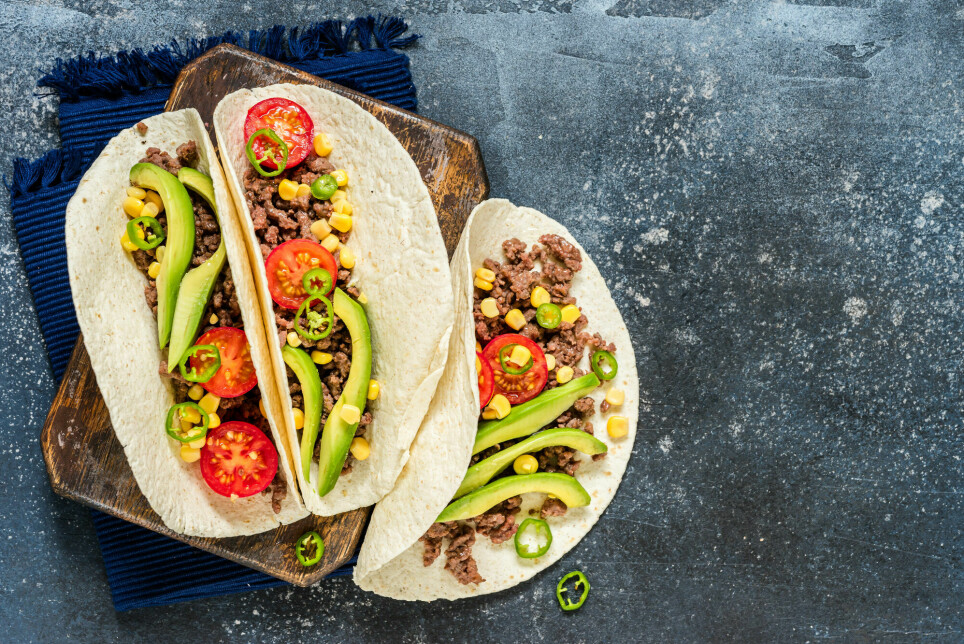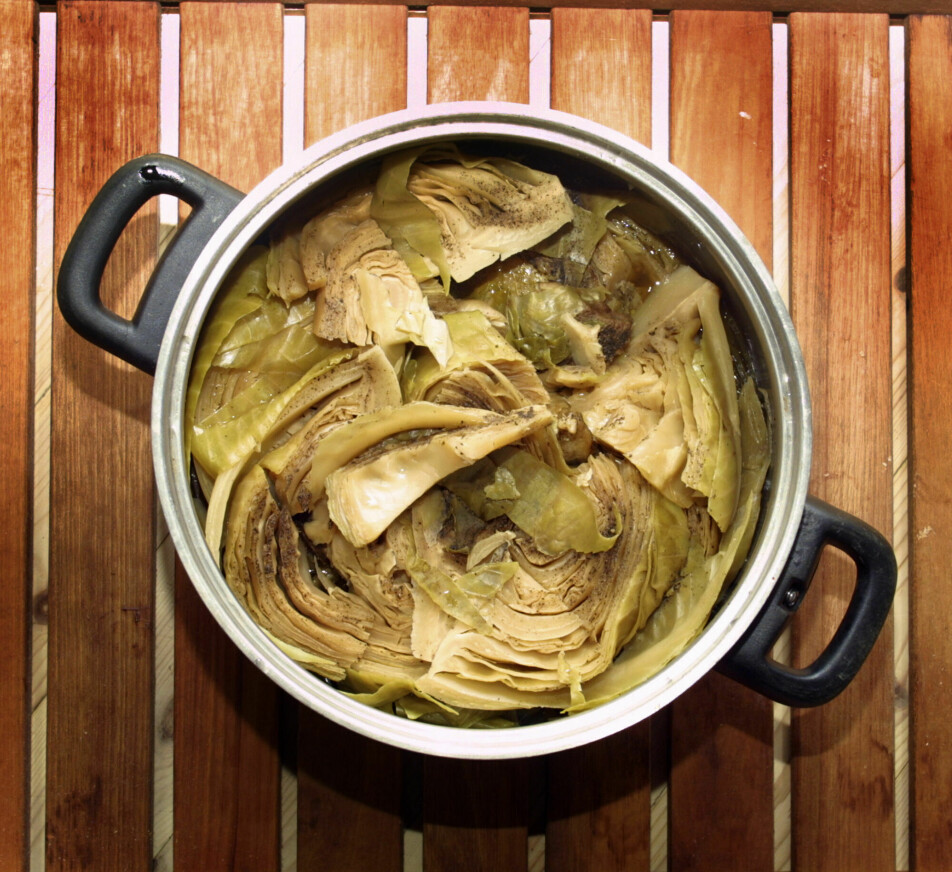
Is this Norway's new national dish?
A couple of decades ago, Norwegians thought tacos were exotic and exciting. Now 80 per cent eat tacos and other Tex-Mex food more than once a month.
In 2014, Norwegians thought it was over and out for fårikål, a mutton and cabbage dish that was first awarded the status of Norway’s national dish in 1972. A survey was undertaken to see what Norwegians actually ate, and what Norwegians themselves thought should be the national dish.
Fårikål took a narrow victory over Norwegian meatballs in the 2014 survey. Four out of ten Norwegians reported eating fårikål once a year or more often, with older Norwegians more likely than their younger compatriots to eat the dish.
In the aftermath of the 2014 survey, Sylvi Listhaug, then Minister of Agriculture and Food, once again crowned fårikål as Norway's national dish. Forty-five per cent of respondents had voted for fårikål as the winner.
But today, far more Norwegians eat tacos and other Tex-Mex foods than mutton and cabbage. And the popularity of these dishes continues to grow.
In her master's thesis “Taco Norway: The History of a National Dish”, Miriam Angela Folland calls tacos a “national dish”. Folland is a master’s student who is studying to be a secondary education teacher in history.
So are fårikål’s days numbered?
Interest grew significantly in the 1990s

“I like to say that the taco is Norway's unofficial national dish because it has gradually become a kind of Norwegian identity marker. Norwegians like to ski, watch traditional Friday night television shows from the Norwegian Broadcasting Corporation (NRK) and eat tacos on Fridays,” Folland wrote in an email to sciencenorway.no.
“Tacos have been popular for so long and are eaten by many people every week, in contrast to fårikål, which most people only eat a couple of times a year. No other dish is such a big part of our everyday lives that way,” she wrote.
Tacos have been awarded a special place in the hearts of Norwegians. Annechen Bahr Bugge can confirm this. Bugge is a sociologist and researcher at the Consumer Research Institute SIFO, at Oslo Metropolitan University (OsloMet)
She has been studying food, food culture and eating habits for many years. She has also written written a book called Fattigmenn, tilslørte bondepiker og rike riddere (Fried crullers, apple brown betty and grilled sandwiches), which looks at eating habits in Norway from the 16th century to the present.
“It was in the 1990s that Norwegians’ interest in Tex-Mex food — and the frequency with which they ate it — increased substantially and became a very important part of Norwegian eating habits. Nine out of ten people under the age of 40 have a clear preference for tacos and Tex-Mex,” she said to sciencenorway.no.
Mandatory in families with children
She says that the number of Tex-Mex meals eaten by Norwegians has also increased in recent years. Her figures show that eight out of ten Norwegians eat Tex-Mex dishes once a month or more. Two out of ten eat Tex-Mex once a week or more.
The people who eat tacos the most, most often live in households with children, or in households with adults under 40 years old. Ninety per cent eat Tex-Mex once a month or more if they have children or are eating dinner with their family.
However, consumption patterns vary greatly between age groups. Among those over 60, only two out of ten eat Tex-Mex once a month or more. The figures, which Bugge has taken from her own book, show that there is not much difference between city and country folks.

Taco Bell – the McDonald’s of tacos
Miriam Angela Folland writes in her master's thesis that the arrival of tacos in Norway is largely due to globalization, Americanization and what she calls McDonaldization.
This last concept includes the idea that traditions and values, such as old-fashioned cooking, are replaced by a quick meal from the nearest fast-food restaurant.
What McDonald's is for burgers, Taco Bell is for tacos in the United States.
Taco Bell quickly became a success after its inception in 1962. And so the Americans made their own versions of a Mexican dish.
Not unexpectedly, the taco did not come directly to Norway from Mexico, but via the USA.
“The Norwegian variant is very similar to the one served in California in the 1960s and which was commercialized by Taco Bell. But it has some adaptations, such as minced meat and cheese,” Bugge says.
Tacos and Tex-Mex are just one of many things Americanization has brought to Norway. Bugge says that the United States has been the major opinion maker in the decades after World War II. Coffee bars have become popular in Norway — and have come to Norway via the USA, just like tacos.

Taco-hungry petroleum workers
The first importer of Tex-Mex products was Allert Middleton, a grocer in Stavanger. It’s no coincidence that Stavanger became the cradle of taco cuisine in Norway.
In the 1960s, taco-hungry Americans flocked to Norway in search of oil — and at that time, the coastal town of Stavanger was the base for all of Norway’s North Sea oil exploration.
Middleton’s story was told by NRK in 2018.
And in 1968, the Olympics were held in Mexico. That also helped build interest in Mexican-inspired food, Bugge said.
The Norwegian company Oluf Lorentzen started importing Tex-Mex from Old El Paso in 1971.
The 1980s: The decade of new words and new food
When Annechen Bahr Bugge studied Norwegian dinner, she was particularly interested in new words.
“From the mid-1980s, many new words began to appear, such as tacos, burritos, empanadas, guacamole and Tex-Mex. Studying new words is incredibly rewarding. It was one of my methods of discovering what happens to the food culture when new words start appearing in the language,” she says.

Foreign food words thus testify to new food that has come from outside. But the popularity of Tex-Mex food is not a particularly Norwegian phenomenon at all, says Bugge.
“We are influenced by food culture phenomena. When television came along, eating habits changed,” she says.
Suddenly, Friday and Saturday night meals were being eaten in front of the TV. Pizza was first, but then the tacos became associated with Friday and Saturday cosiness in the same way as pizza had been.
Food is more than fuel
Food is never just fuel, Folland wrote in her master's thesis. The food we eat is closely linked to our cultural identity.
She believes that taco-hungry Americans who came to Norway to work for the oil industry can’t fully explain how the dish became so popular with Norwegians.
An important reason for the taco's popularity is that the dish is social, she says.
Simple questions like "can you pass me the sour cream" quickly lead to "how has your day been?" — and in this way, tacos open up opportunities for conversations around the table.
Popular dish for many different celebrations
And the taco can easily be made to suit many different occasions.
“We eat tacos when we celebrate, whether we’re celebrating the weekend, a birthday or each other's company. The buffet style makes the meal something to gather over, something to do together. It integrates well into a busy everyday life, because it feels special, while at the same time it’s easy to prepare,” Folland says.
And it quickly went from being exotic to becoming popular. So did the ads for Tex-Mex.
The taco is perfect for humble, modern, globalized, traditional, family-oriented and egalitarian Norwegians, she wrote in her thesis.
Easy, partly ready-made and with a personal touch
“When I wrote my doctorate on dinner food, I saw that people are torn between home-made and completely ready-made foods. Tacos allow you to use some ready-made sauces at the same time as you fry and cut and make foods yourself. You can give the food a personal touch when you mix things and do tricks with ready-made packaged products,” Bugge said.
“It’s more accepted to use ready-made foods for new, exciting and exotic dishes where you aren’t so familiar with how to mix the spices,” she said.
At the same time, tacos and Tex-Mex have acquired an increasingly personal and homemade touch over time, Bugge said.
“The last thing I was served at a conference were vegetarian tortillas that were absolutely beautifully prepared! This dish is constantly evolving,” she said.
Can the taco withstand the vegetarian wave?
And vegetarianism is a thing: more and more Norwegian are cutting back on meat consumption. In 2020, the private television news channel TV2 was able to report that the number of vegetarians in Norway had doubled in one year.
In total, eight per cent of Norwegians have completely cut out meat and fish, TV2 reported. However, the vast majority categorize themselves as flexitarians, who are people who have cut their meat consumption. Twelve per cent of Norwegians identify as being in this group.
Tacos are a dish that is suited to being made with less meat, Bugge said.
“Tacos work well with less meat. There is a growing interest in vegetarian eating patterns, but very few people cut out meat completely. The most common strategy is to reduce the meat in meat dishes. It is easy to increase the proportion of vegetables in dishes like tacos,” she says.
She has also seen that many people who cut out meat completely use meat substitutes, or beans and lentils as protein sources in tacos.
The dish’s adaptability is one of its greatest strengths, says Folland.
“This means that it adapts to and transcends societal changes, such as the vegetarian wave, changing health advice and other food trends,” she says.
“It can also be adapted on an individual level. You can choose whatever you want to put on them. You can also make them as simple or as fancy as you want,” she said.

Traditional food is still important
If tacos are on the way to becoming a national dish, or have already become the national dish — does that mean that fårikål is on its way out?
“There is a growing interest in traditional food. I don’t think fårikål is on its way out,” Bugge said.
She cites another uniquely Norwegian dish, pinnekjøtt (lamb ribs) as an example of a traditional food that has increased in popularity.
“Pinnekjøtt was something that very few people ate 20 years ago, but now it has become incredibly popular. And more and more people are trying other traditional dishes such as rakfisk (salted and fermented trout or char) and lutefisk (a casserole made from dried salted cod), she says.
And completely new dishes are being tried out on days other than Friday and Saturday. That trend may have changed in recent decades.
“In the 1970s, new and exotic dishes were often introduced on Friday nights. Now it looks like it’s children who get the right to decide what’s on the menu on Friday and Saturday evenings,” Bugge said.
Now tacos have become known and loved by most Norwegians. And there are many indications that Taco Friday is still going to be strong for a long time to come.
Nothing about tacos in Norway is a given
Folland said she wrote her thesis on tacos in Norway because she likes the idea of using food as a lens through which to look at history.
“I think it is very interesting to try to understand history through the food we eat,” she said.
Food is an essential part of everyone's life and always has been. Nevertheless, food history is a relatively new and little-explored field, Folland said.
“Tacos were extra exciting because they have always been a given in my life, but nothing about tacos in Norway is a given, of course,” she said.
Translated by Nancy Bazilchuk
Read the Norwegian version of this article on forskning.no
Reference:
Folland, Miriam Angela. (2021). Taco Norway: The History of a National Dish. Master's thesis in History for the lector/secondary teacher education programme, University of Oslo.






























